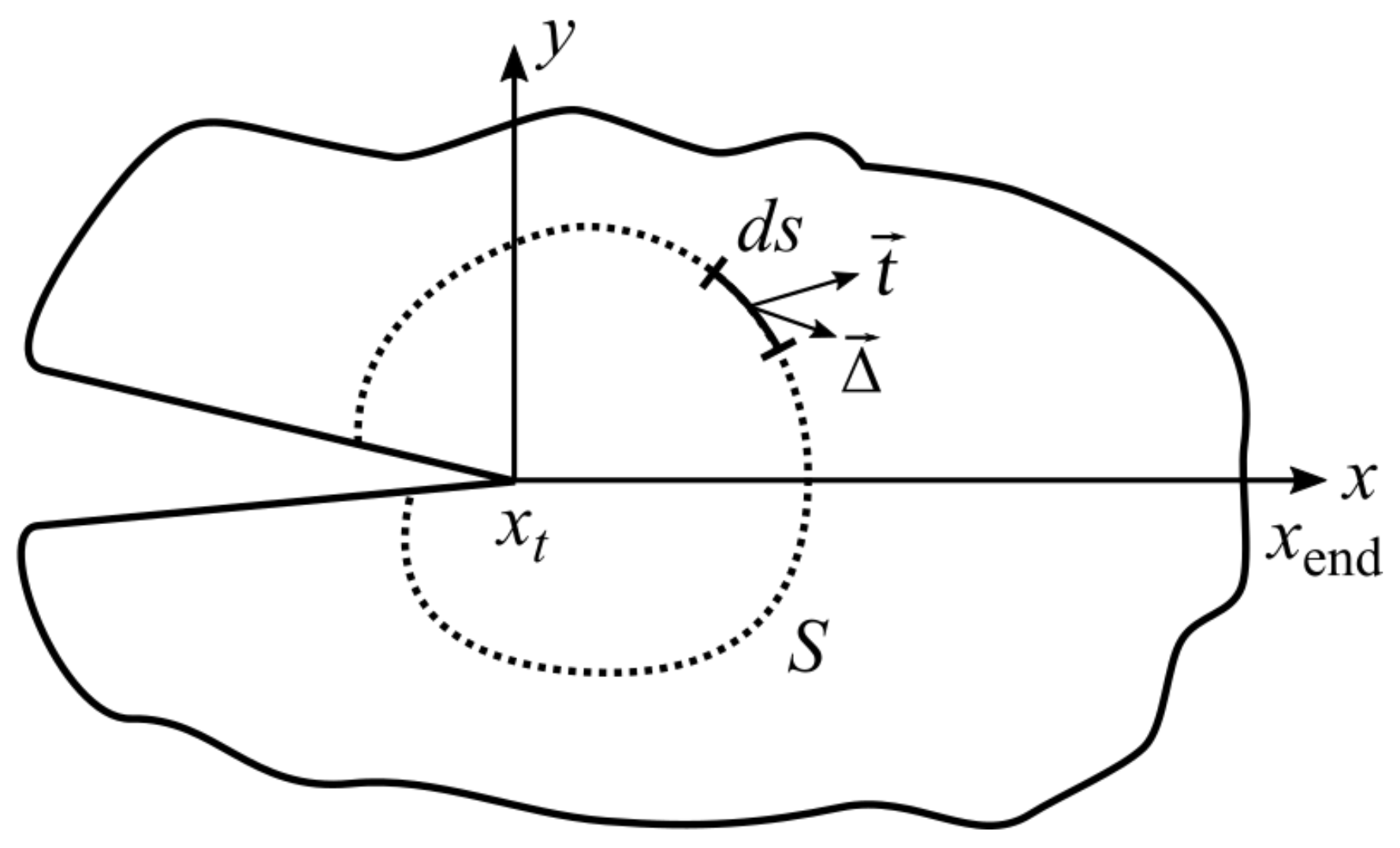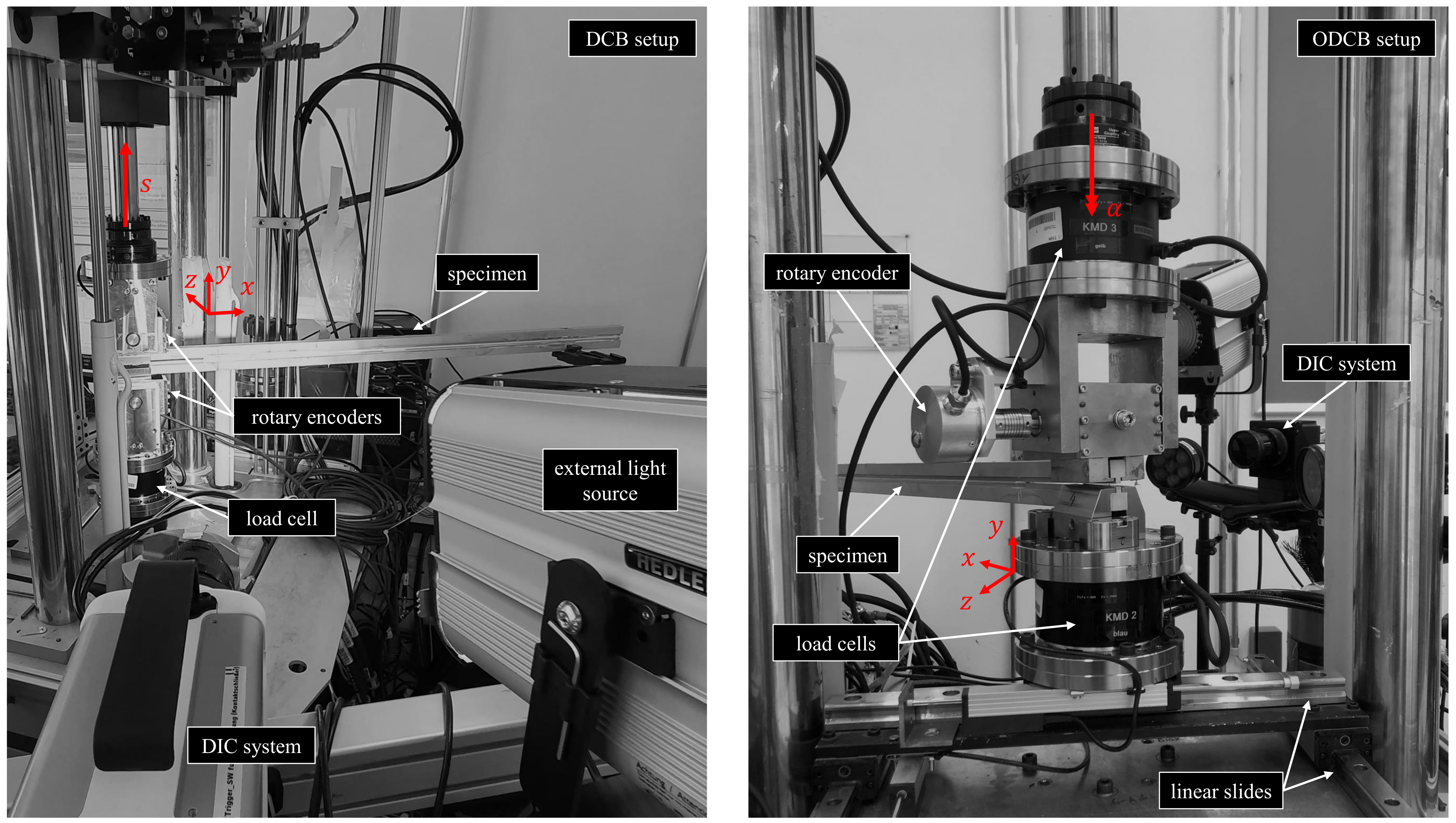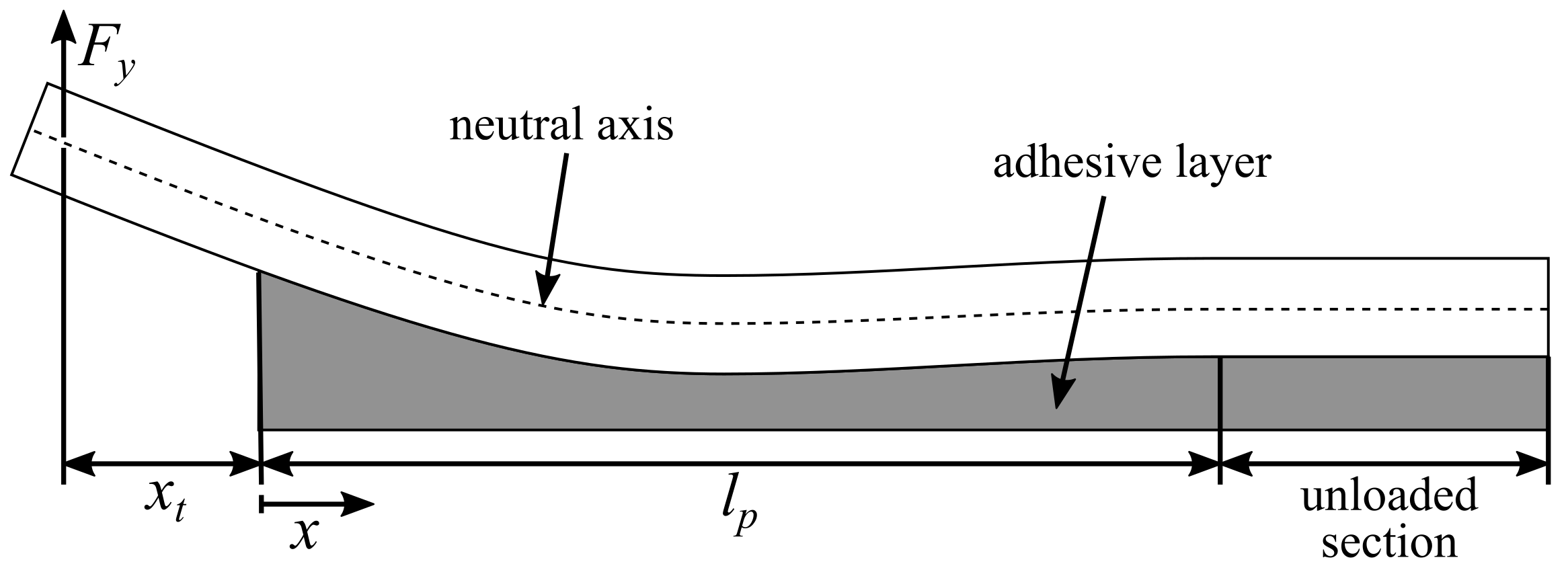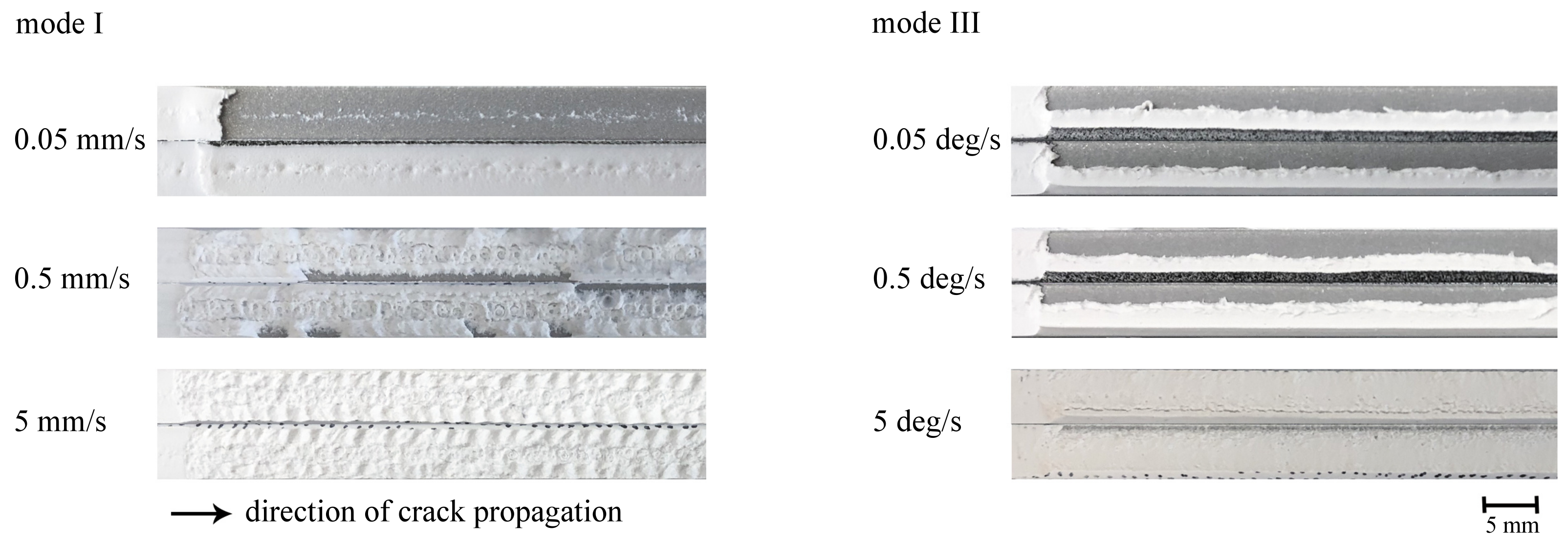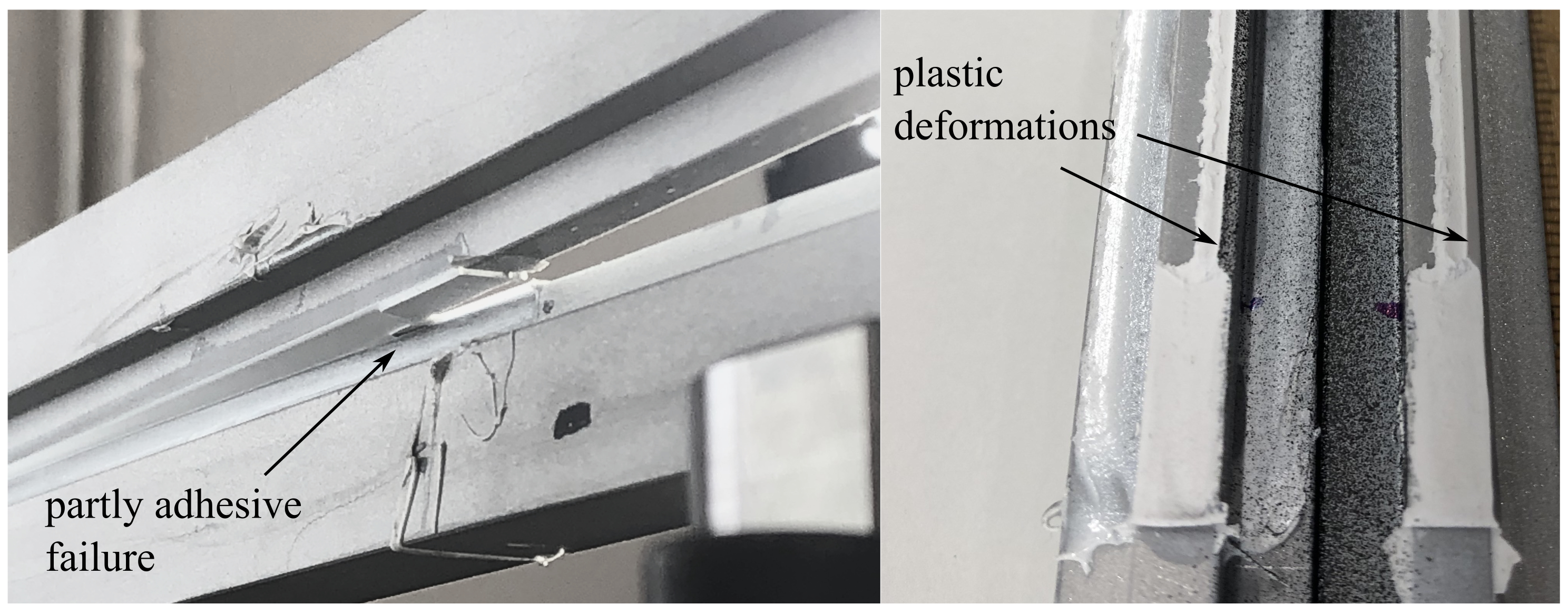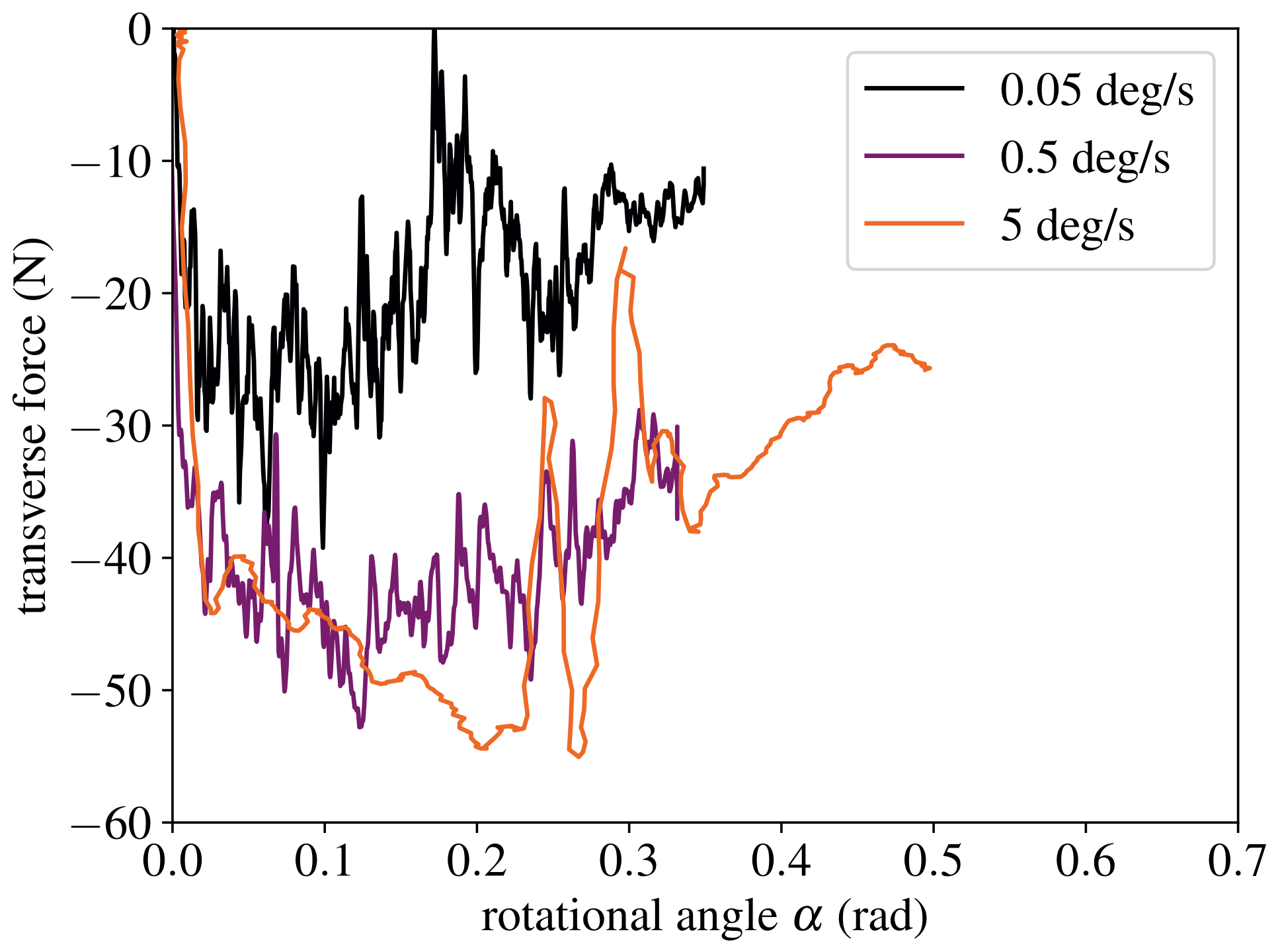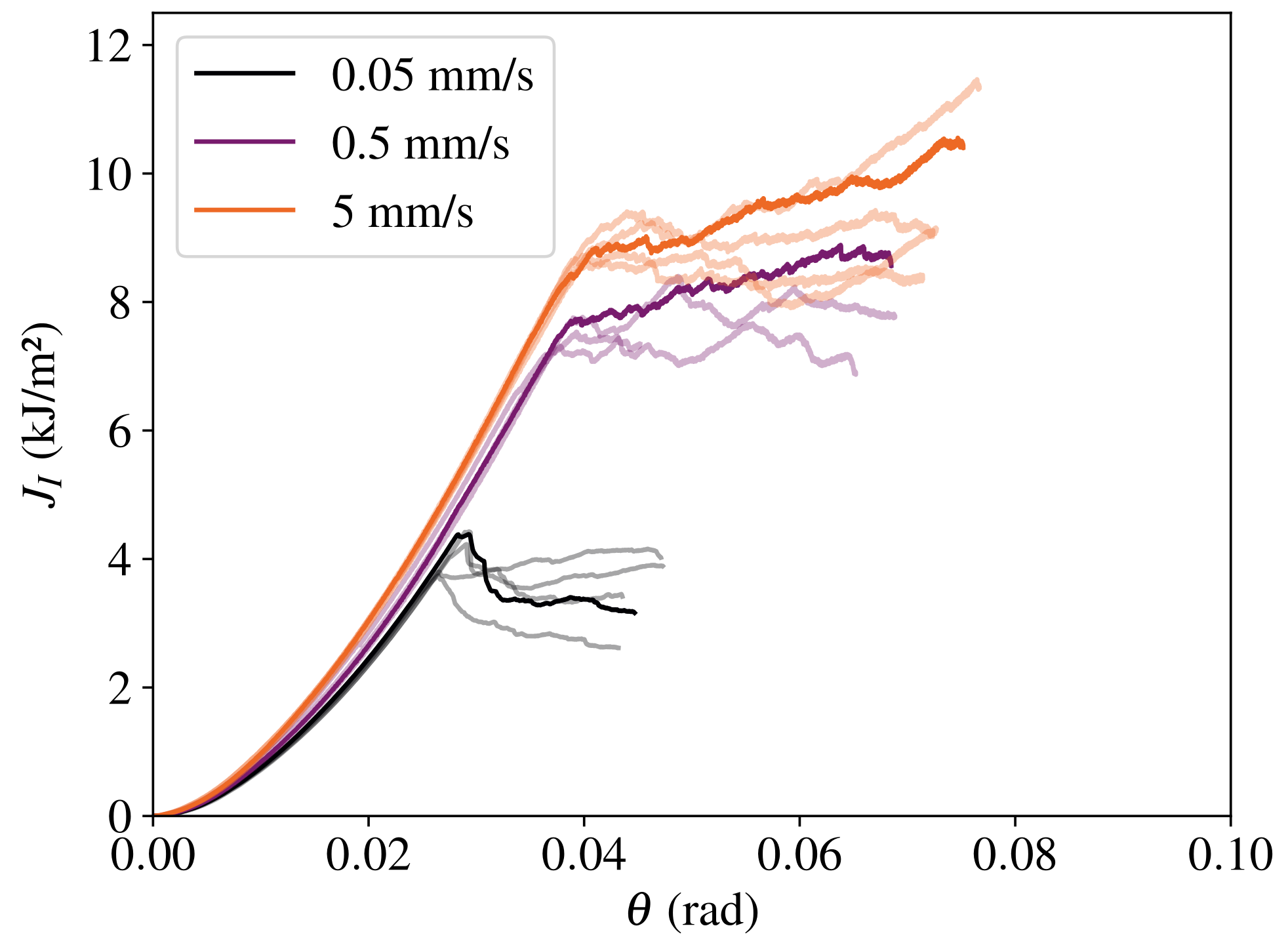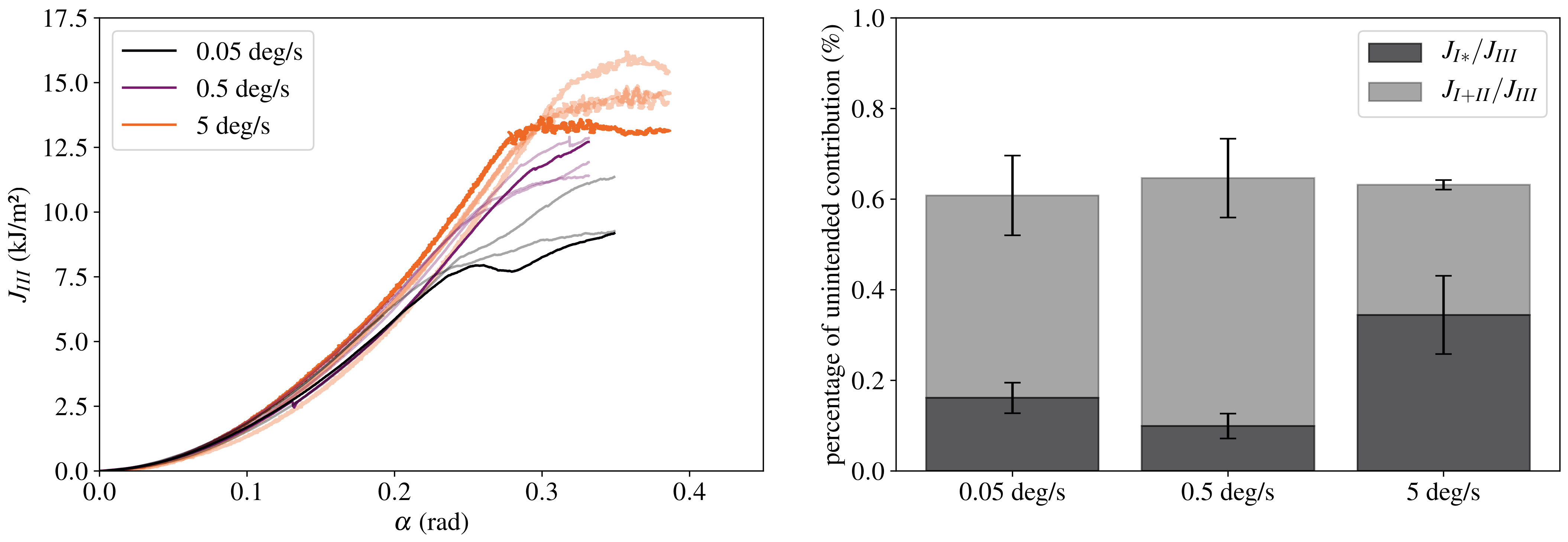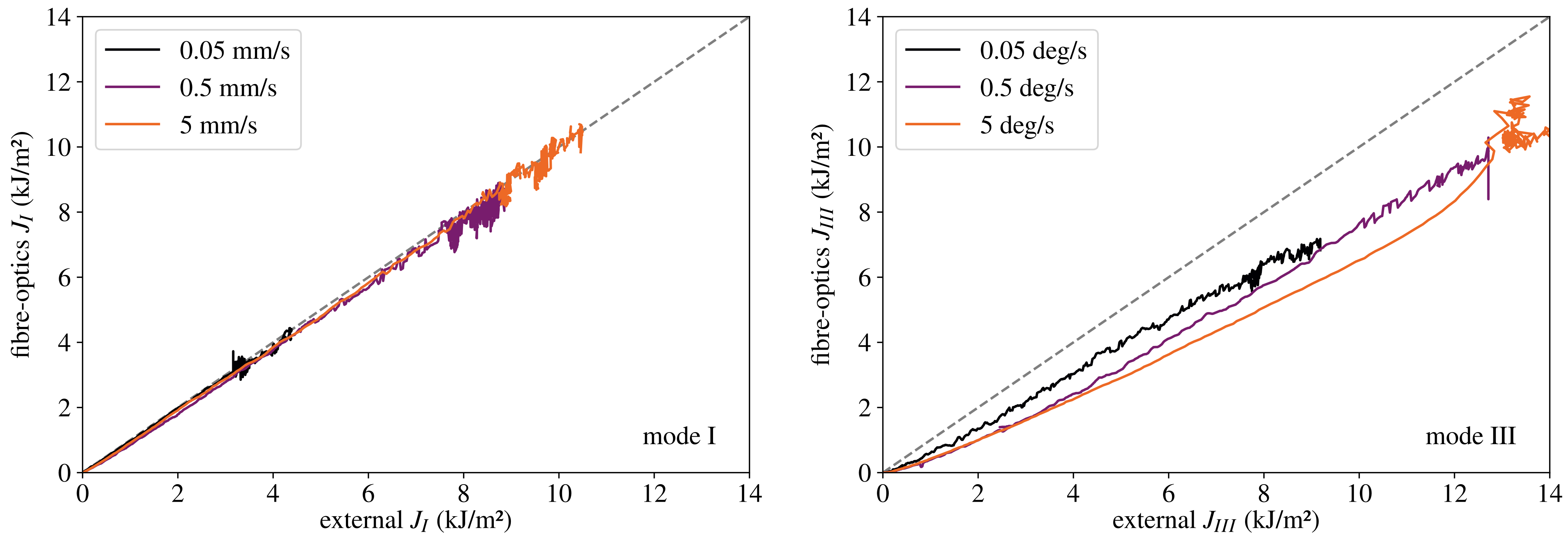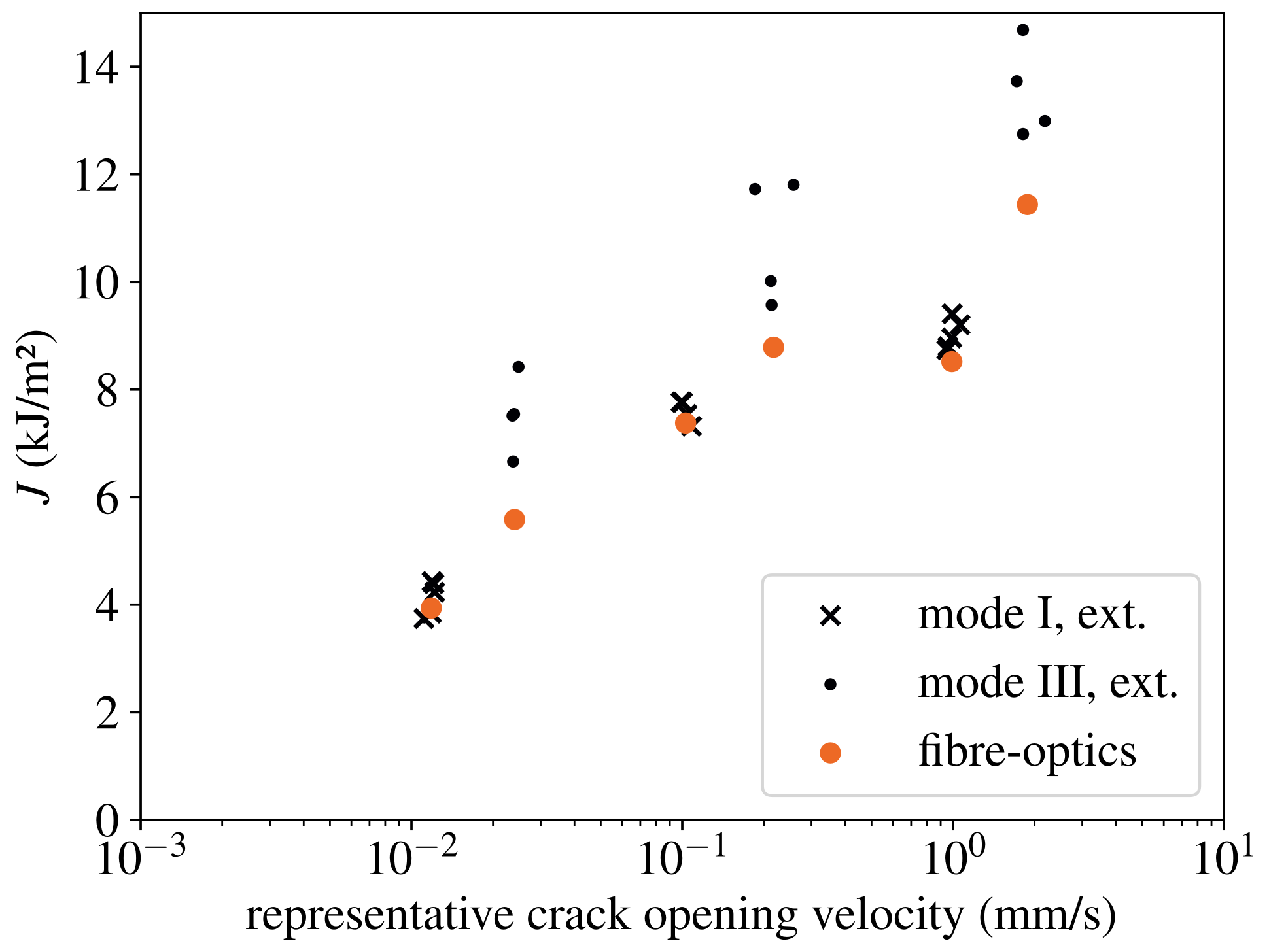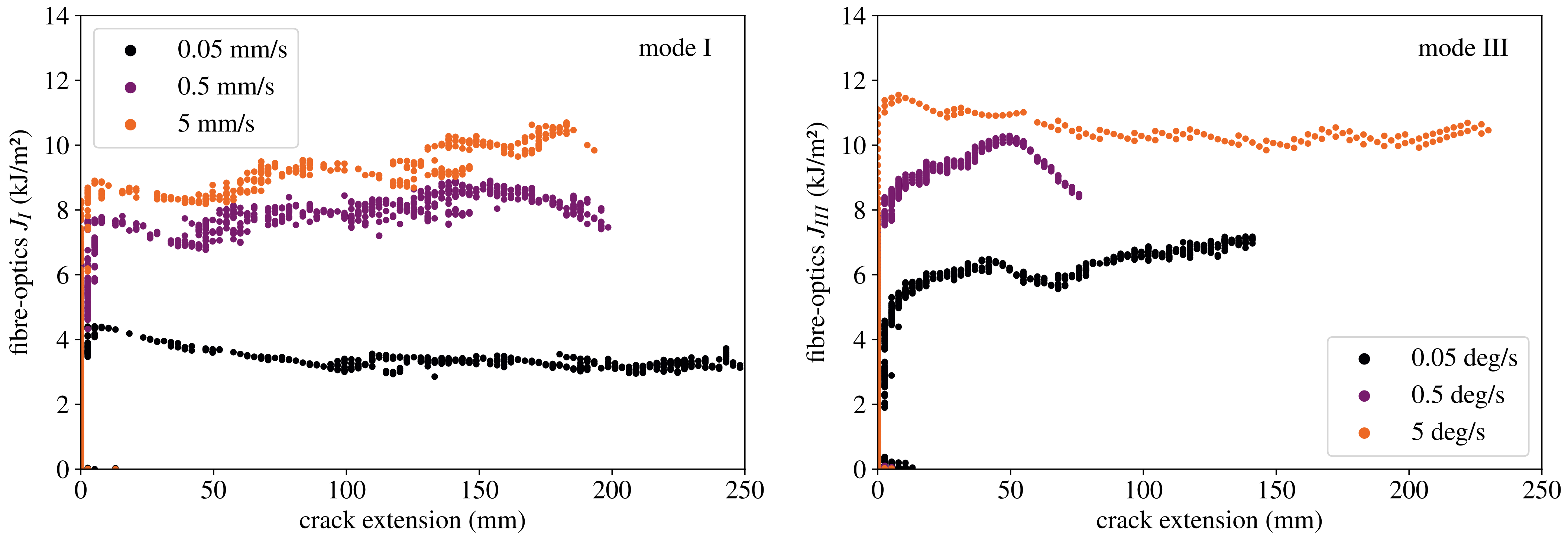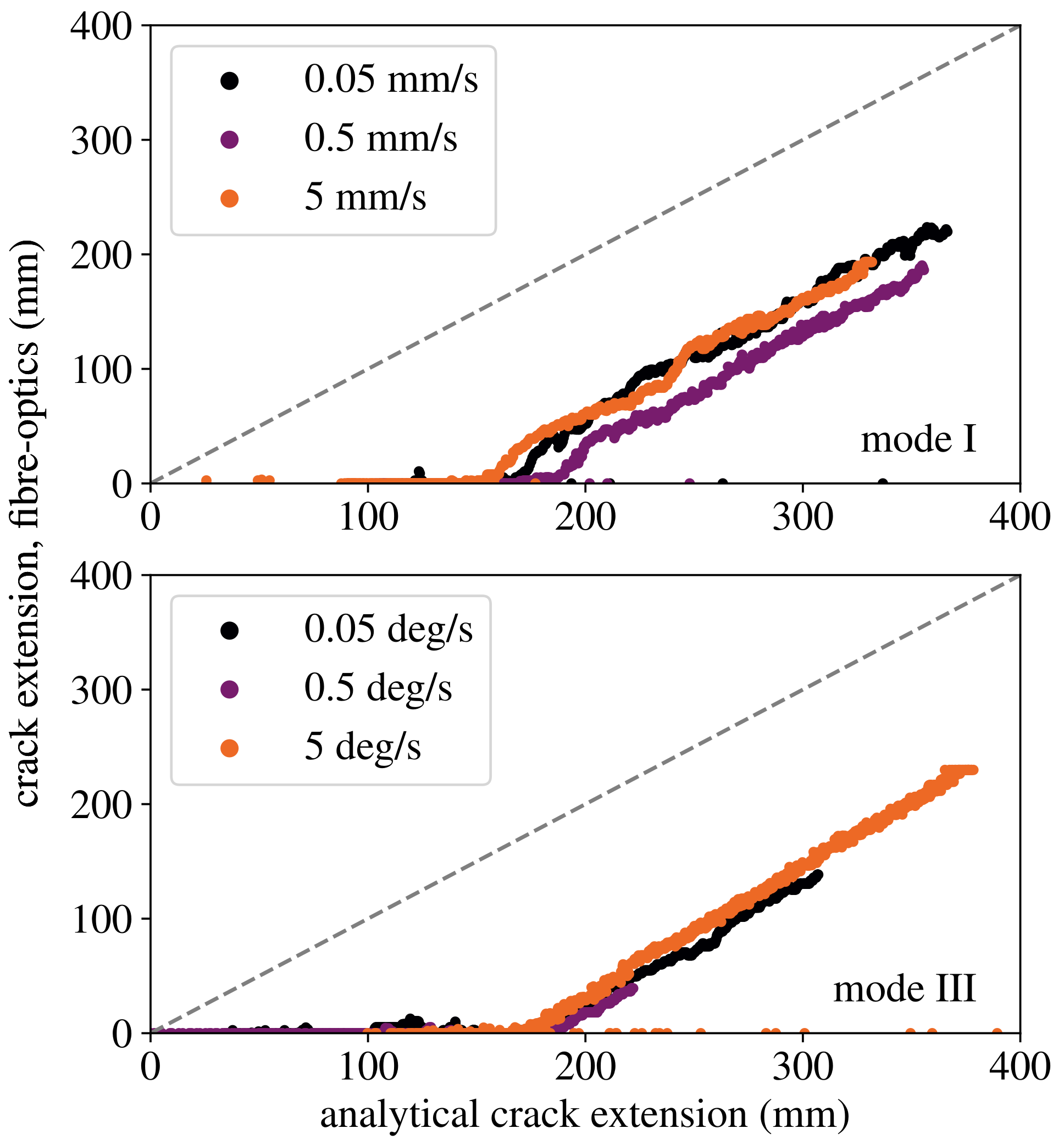1. Introduction
The literature contains a large number of studies investigating the fracture behaviour of epoxy-based adhesives but comparatively few works investigating soft, rubber-like polyurethane-based adhesives. However, many authors agree that polyurethane adhesives have various advantages in terms of the more even load distribution of peel loads, higher elongation at break, good damping properties and fatigue resistance, and energy consumption during impact [
1,
2,
3]. The latter is of particular importance in passenger protection, as increased fracture energy leads to a greater amount of energy being absorbed by the adhesive layer in the event of a crash accompanied by finite deformations in the adhesive layer, which could potentially help to minimise personal injuries. Despite these important factors, only a few studies have investigated the fracture behaviour of polyurethane-based adhesive joints, whereas numerous studies have been conducted on polyurethane adhesives in their bulk form. It is assumed that this lack of research may be due to issues such as large process zones and energy dissipation through viscoelastic or viscoplastic effects, as well as creep processes complicating both the experimental investigation of the fracture behaviour and the extraction of fracture mechanical parameters.
The determination of cohesive laws is of particular importance for the design of adhesively bonded joints, because from these, by use of cohesive zone modelling, the behaviour of the joint can be predicted efficiently in finite element analyses. The aim of cohesive zone modelling is to reproduce the macroscopic fracture behaviour of the adhesive layer by the use of traction separation relations, which, in the best-case scenario, can be evaluated directly from mechanical fracture experiments such as, e.g., the double cantilever beam (DCB) test, the end-notched flexure test, or the out-of-plane loaded double cantilever beam (ODCB) test in modes I, II, and III, respectively. Commonly, an evaluation method based on the
J-integral according to Rice [
4], in which the cohesive laws are obtained by taking the derivative of the externally measured
J-integral with respect to the crack opening displacement (COD), is used for this purpose in the single mode testing of both stiff, epoxy-based, e.g., [
5,
6,
7,
8,
9,
10,
11], and soft, rubber-like adhesives, e.g., [
12,
13,
14]. The approach assumes a purely non-linear elastic material behaviour, with the crack tip being the only inhomogeneity in the body, which, however, could be a problematic assumption for testing soft, rubber-like adhesive systems because the effects of the loading rate and energy dissipation outside of the crack tip, i.e., in the process zone, may not be taken into account accordingly. For pure mode I loading, Rosendahl et al. [
14] showed that the approach can, indeed, approximately be used for thick, hyperelastic adhesive layers under quasi-static conditions using finite element analyses. However, this finding remains to be verified experimentally. Furthermore, in the mode III testing of rubber-like adhesives, in which the process zones are significantly larger than in mode I [
15], the approach has not yet been used. To experimentally investigate the applicability of the
J-integral method, the aim of our study is to propose an alternative methodology for determining cohesive laws based on the deflection curve of the adherends in DCB and ODCB tests to circumvent the underlying assumptions of the
J-integral approach, e.g., rate-independent material behaviour and negligible effects of the process zone. As we will show, this novel method also has some additional advantages in accounting for rate-dependent fracture behaviour, as it can also be used to directly measure rate-dependent cohesive laws.
The dependency on loading rate and mode on the energy release rate (ERR) of rubber-like adhesives has also been investigated in some recent studies: In pure mode I testing, Schmandt and Marzi [
12,
13] investigated the effect of loading rate and adhesive thickness on the fracture energy, cohesive strength, and joint stiffness of polyurethane-based adhesives with DCB tests using the above-mentioned method of evaluation and found that fracture energy and cohesive strength show dependencies on both the loading rate and layer thickness. Boutar et al. [
16] investigated the quasistatic single mode I and mode II fracture of a polyurethane-based adhesive system and found a significant dependency of the obtained fracture energy on the loading mode, with the mode II fracture energy being over three times larger than the mode I fracture energy at a layer thickness of 1 mm. In contrast, Loh and Marzi [
15] investigated the mixed-mode I+III behaviour at a layer thickness of 3 mm and found that there could be an indication that the critical fracture energy of thick polyurethane-based joints does not depend on the mode-mix ratio. However, they also stated that the experimental scatter in their results did not allow a definitive statement about this issue. Furthermore, because of a pronounced resistance curve behaviour, they were unable to determine the cohesive traction in the adhesive layer with the
J-integral approach, which also indicates that finding another methodology that allows the determination of the cohesive traction for such soft, rubber-like adhesive layers is an important advance in the state of research.
As hinted at earlier, the determination of process zone length and crack tip position is also of interest for the investigation of the fracture behaviour of adhesive joints: considering the determination of crack length, Schrader et al. [
17] found that the crack extension measurement for rubber-like adhesive joints proved to be a difficult task with both optical methods of crack length measurement and the enhanced simple beam theory approach according to Škec et al. [
18], leading to the conclusion that other methods for determining an equivalent crack tip position could be advantageous. Hence, as an alternative, we rely on an approach based on measurements on the adherends’ backface strain (BFS) within this study, as the measurement of the BFS also allows the determination of the deflection curve of the adherends, which is crucial for our aim of determining the cohesive traction without underlying
J-integral assumptions. Similar approaches have already been established in some other studies with a focus on the pure mode I testing of stiff adhesive systems: Ben Salem et al. [
19] used several strain gauges along the top surface of a DCB specimen bonded by a structural adhesive joint for crack tip detection and identified the crack tip position from the position of the maximum bending strain. Similarly, Bernasconi et al. [
20] and Lima et al. [
21] used optical backscatter reflectometry to obtain the adherends’ BFS. Truong et al. [
22] also calculated the resistance curve for a composite specimen from BFS measurements. To obtain a deflection curve during DCB experiments, Reiner et al. [
23] and Sun and Blackman [
24] used digital image correlation (DIC) to obtain the displacement profiles, enabling the calculation of the ERR from the obtained displacement data. Additionally, especially for the investigation of soft adhesive systems, a measurement of strain along the adherends allows the investigation of the process zone shape, as performed, e.g., by Jumel et al. [
25]. Schrader and Marzi [
11] recently investigated a stiff, epoxy-based adhesive system in mode III loading and also calculated both crack length and process zone length from the measured BFS of the adherends. They also noted that the investigation of the process zone using BFS measurements could be of particular interest for investigating soft, rubber-like adhesive layers. Hence, the state of research indicates that BFS measurements seem to offer valuable data for determining cohesive laws from the experimental results.
Building on the mentioned studies, the present work aims to, for the first time, holistically investigate the effects of crack opening velocity and loading mode on a soft, rubber-like polyurethane-based adhesive joint, especially considering the determination of cohesive laws. Differences between the different evaluation methods, i.e., the J-integral method and BFS measurements, shall be investigated, highlighted, and discussed in order to gain insight into the applicability of the J-integral approach for soft, rubber-like adhesive layers, because, as hinted at earlier, some of its underlying assumptions may be violated for such adhesive systems. Furthermore, measuring the BFS along with the adhesive layer offers the hitherto unprecedented opportunity to investigate whether the cohesive law measured at the crack tip is at least similar to the cohesive traction separation relations along with the complete adhesive layer.
For this reason, we performed DCB and ODCB experiments on a soft, polyurethane-based adhesive system (Wiko Ultimate Elongation GLUETEC Industrieklebstoffe GmbH & Co. KG, Greußenheim, Germany) in both DCB and ODCB tests at different loading rates, i.e., 0.05 mm/s, 0.5 mm/s, and 5 mm/s in mode I and 0.05 deg/s, 0.5 deg/s, and 5 deg/s in mode III. In each of the test series, one experiment with a fibre-optics-based BFS measurement was performed to investigate the deformation behaviour of the adherends and to compare the results with the conventionally used evaluation methods for the determination of cohesive laws based on the J-integral.
We shall begin by briefly presenting the necessary theoretical background on the evaluation methods based on the J-integral and BFS measurements of the DCB and ODCB experiments. After stating the materials and methods, we shall present and thoroughly discuss the most important experimental findings. This includes the observed fracture patterns, the bending strain measured by the optical fibres, the rate-dependency of the ERR in modes I and III, the obtained resistance curves, the measured process zone lengths, and the cohesive laws. Furthermore, the BFS measurements are compared to the globally measured data to verify the used evaluation approaches. As we will show, the determination of cohesive laws from the deflection curve of the adherends is a valuable addition to fracture mechanical testing, as the conventional J-integral method of determining the cohesive traction may be prone to error because the underlying assumptions could be violated for soft, rubber-like adhesive layers. Additionally, the presented method based on the BFS measurement allows the determination of a rate-dependent cohesive law, which, to the authors’ knowledge, has not been achieved elsewhere.
4. Results and Discussion
4.1. General Observations and Fracture Surfaces
In all cases, large displacements at the initial crack tip are observed before the crack starts to propagate. During quasi-static mode I loading, the crack travels directly to the nearby interface, followed by adhesive failure, which is commonly observed regarding the quasi-static peeling of adhesive joints [
12]. With increasing loading rate, the mode I failure becomes more cohesive (cf.
Figure 6). In the ODCB experiments, due to finite deformations at the crack tip, the mode III shear transitions into a peel load accompanied by partly adhesive failure at highly stretched parts of the joint (cf.
Figure 7). Interestingly, the large displacement aspect during mode III loading indicates crack propagation perpendicular to the actual bonding surface, accompanied by partly adhesive failure at the outer edges of the adhesive layer. This is probably related to the general tendency of the adhesive to fail adhesively at particularly slow rates. It is assumed that during loading, highly stretched parts of the joint at the outer boundary fail adhesively, hence, reducing its effective width before an ultimate cohesive failure occurs. However, this behaviour ceases at an increased rate of 5 deg/s, as the fracture surfaces show a tilted fracture surface with purely cohesive failure. In
Figure 7, it can also be observed that the outer edges of the adhesive layer opposing the side of partly adhesive failure are tilted and plastically deformed.
4.2. BFS Obtained from the Fibre-Optics Measurements
Figure 8 shows the development of the bending strain in the optical fibre over the runtime of a DCB and an ODCB test at different selected times during the measurement. For better visualization, the zero value of the abscissa is set at the initial crack tip position. Independently from the loading mode, the process zone is already quite large at the beginning of the crack propagation, strongly indicating that the assumption of an infinitesimally small process zone is violated.
In the mode I experiments, the maximum strain first increases with the applied load and then begins to shift along with the specimen as the crack progresses. Furthermore, the bending strain behaves linearly in front of the crack tip, indicating that a constant transverse force is applied in the lever arm. Deviations from linearity can hence be ascribed to the adhesive layer, indicating that the selected criterion for the detection of the crack tip position delivers satisfactory results.
In the mode III experiments, although one would expect a constant bending strain in the region of the lever arms because of the applied bending moment
, a linear growth of the measured strain can be observed, indicating that an additional transverse force, probably due to friction in the lateral slides below the lower clamping device, acts on the specimen. The transverse force obtained from the BFS measurement, i.e., the slope of the measured strain in the region of the lever arms, is displayed in
Figure 9 for the different loading rates. As the slope is determined through the numerical differentiation of the strain data, the measurement noise is amplified, yielding the observed fluctuations in the displayed transverse force. The assumption of friction being the main reason for the transverse forces is supported by the fact that the resisting force is relatively constant after a certain break-away force of the linear slides is reached. Because this resisting force is counter-directed to the applied moment component
, it will inevitably reduce the traction and the value of
J in the adhesive layer. This result, which unfortunately only became apparent during post-processing, was rather unexpected. While this will not influence the BFS evaluation, it must be assumed that the influence has a significant impact on the evaluation of
J from the external measurements, as it cannot be considered with the used method of evaluation for the ODCB tests.
4.3. Comparison between BFS, Load, and DIC Measurements
Before further investigating the fracture behaviour of the tested adhesive joints with the BFS measurements, it shall be investigated whether the results can be verified with the globally measured data of the COD and applied load. In
Figure 10, the results for two representative specimens (nominal adhesive layer thickness of 1 mm at the lowest loading rate) are shown for both the mode I and the mode III experiments. As can be observed, the separation at the initial crack tip obtained from both the DIC measurement as well as the values from the BFS measurement show a good agreement, indicating that the separation of the adherends can be determined from the BFS measurement with good accuracy. As the measurement data of the BFS measurements are integrated along with the complete specimen to obtain the COD at the position of the crack tip
, cf. Equation (
11), this means that the separation at each measurement point along the adhesive layer can be determined reliably. As the shear force in mode I is constant in the lever arms in front of the crack tip, the values obtained by the BFS measurement may be compared with the values measured on the external load cells as well, also showing a very good agreement. To compare the moments in mode III, the observed slope in the fibre bending strain in front of the crack tip is extrapolated to the point of load introduction. Here, the external moment measurement also agrees well with the moment obtained from the BFS measurement. Overall, the good agreement of the external measurement of COD and applied load with the BFS measurements indicate that the methodology proposed in
Section 2.3 delivers valid results.
4.4. Influence of Loading Mode and Loading Velocity on the ERR
The mode I ERR obtained from Equation (
5) is shown in
Figure 11 over the measured rotational angle
; for a better overview, the tests conducted with BFS measurements are highlighted. As expected, the measured values for
J at fracture initiation increase with the loading rate. The large discrepancy between the obtained ERR at 0.05 mm/s and 0.5 mm/s can be related to the adhesive failure observed during the quasi-static experiments.
In
Figure 12, the mode III ERR according to Equation (
6) over the rotational angle
and the relative influence of the unintended contributions to
J at the onset of fracture according to Equation (
7) are displayed for each loading rate. Here, it can be observed that, during the experiments at 0.05 deg/s and 0.5 deg/s, the ERR does not reach a steady plateau throughout the experimental investigation, already indicating that the ERR is rising with crack propagation, yielding a resistance curve (cf.
Section 4.5). It can also be observed that the unintended contributions from the transverse moments are indeed negligible at the point of fracture, which is in good agreement with the results of prior investigations [
10,
15,
27,
28]. This also allows the conclusion that the BFS measurement, although affected by a transverse force, is not influenced significantly by the moment components responsible for the unintended contributions to
J.
Figure 13 presents the values for
J obtained from Equation (
5) and (
6) in comparison to the value obtained from the BFS measurement according to Equation (
13) for the mode I and mode III experiments. Here, a good correspondence between both methods of evaluation can be seen for pure mode I loading. For the mode III experiments, however, it can be observed that the value for
J according to Equation (
6) and the BFS measurement differ greatly from another, with the BFS
J, Equation (
13), being approx. 20% lower than the externally measured value throughout the experiments. As hinted at earlier, this is likely due to the transverse force (cf.
Figure 9), which was observed during the post-processing of the BFS measurements but not recorded during the experiments. This is also undermined by the fact that both the transverse force and the difference between the evaluation methods are the smallest at the loading rate of 0.05 deg/s; for the tests at 0.5 deg/s and 5 deg/s, in which the transverse force is larger, the difference also increases. As the external measurement seems to be strongly influenced by the friction within the lateral slides, the results from the BFS measurements clearly show that the evaluation of the ODCB test has to be revised for the testing of soft, rubber-like adhesive layers in future investigations.
To estimate the dependency of
J on the loading rate and loading mode, the values of
J at crack initiation are displayed over the representative crack opening velocity in
Figure 14. The representative crack opening velocity was determined from a linear regression of the COD vs. time in the initial linear region of
, akin to the approaches of Schmandt and Marzi [
13] and Schrader and Marzi [
10], respectively. Hence, it shall be highlighted that the representative crack opening velocity is determined locally at the crack tip from the COD measurements and cannot be easily assessed from the external loading rates before testing. Generally, a large discrepancy between the mode I and mode III results is visible if the externally measured values for
and
are considered. However, the values obtained from the BFS measurements indicate that the differences between mode I and mode III mainly result from neglecting the transverse forces due to friction in the lateral slides. Hence, given the limitations of this study, a similar rate-dependency is obtained for both modes I and III, indicating that the ERR could be independent of loading mode, as was also hypothesised by Loh and Marzi in [
15]. This also correlates with the large deformations at the crack tip observed during the mode III experiments, which ultimately yield a local peel load at the crack tip at fracture initiation.
4.5. Crack Propagation, Resistance Curve Behaviour and Process Zone Length
The resistance curves for all tested specimens are shown in
Figure 15. Whereas a constant ERR can be observed in the mode I experiments during crack propagation, the ERR increases with crack extension in the mode III experiments at the lower loading rates of 0.05 deg/s and 0.5 deg/s. Due to the presence of crack extension before reaching the critical value of
J, the cohesive traction cannot be calculated from
, Equation (
4), for these experiments, as although the crack already started to propagate, the cohesive traction would be unequal to nought until the
J-plateau was reached.
The process zone lengths obtained from the BFS measurements are shown in
Figure 16 over the measured crack extension. Generally, the length of the process zone increases until the start of crack propagation and remains constant over the experiment in good approximation in all cases, indicating stationary conditions behind the crack tip even in the case of an observed resistance curve. During mode I testing, the process zone length seems to be largely independent of the loading rate. In the mode III experiments, however, it is noticeable that the process zone length drastically decreases at the loading rate of 5 deg/s, which can likely be ascribed to the partly adhesive failure during the experiments at 0.05 deg/s and 0.5 deg/s. In these experiments, the partly adhesive failure before cohesive crack propagation causes a decrease in the stiffness of the joint and, hence, larger process zones. Additionally, it should be noted that the process zone lengths in mode III are significantly larger than in mode I at the start of crack propagation, which can generally be related to a lower stiffness of the adhesive in shear than in peel.
As stated earlier, a comparison between the crack length obtained from the BFS measurement and the analytical crack length according to simple beam theory is sought. In
Figure 17, the crack extension according to the BFS measurement is displayed over the analytical crack extension during crack propagation. It can be observed that the slope of the curves is relatively close to one in the range of crack propagation in both modes I and III, which correlates with the results of Schrader et al. [
17], who also found that the crack extension can be approximated for soft, rubber-like adhesive systems with simple beam theory assumptions.
Figure 17 also shows that the initial crack length is heavily overestimated by the analytical approach, with the error being around 160 mm in mode I and 180 mm in mode III, which, in all cases, is significantly larger than the initial crack length. As this offset seems to be constant, however, it could be argued that analytically calculating the equivalent crack length would be possible for the given soft, rubber-like adhesive system if the crack length were corrected for the determined offset. Hence, it could be argued that
G-based evaluation methods relying on a corrected beam theory approach could also pose an option for the determination of the ERR for soft, rubber-like adhesive systems. However, it shall be stated that using the
J-integral approach of determining the ERR is likely still favourable in this case, as it allows determining the ERR without the necessity of inferring virtual crack extensions or similar correction factors.
It is advised that future studies investigate the influence of the specimen geometry on the process zone length and crack propagation more closely. As stated earlier, if the process zone reaches the end of the specimen, the assumption of an unloaded end behind the
J-integral evaluation of the cohesive traction is violated (cf. Equation (
3)). A future experimental investigation could, hence, be valuable, especially for the practical design of joints with shorter adhesive layers.
4.6. Cohesive Traction in the Adhesive Layer
The traction at the initial crack tip obtained from the “conventional” method according to Equation (
4) (bold lines) as well as the mean cohesive traction in the complete adhesive layer according to the BFS measurements, cf. Equation (
12), (scatter bands) is shown in
Figure 18 for both modes I and III. It can already be observed that the measured cohesive traction changes with loading mode, as the initial stiffness of the joint is significantly lower in mode III than in mode I. Furthermore, the measured cohesive traction is dependent on the loading rate in both cases, already violating the underlying assumption of Equation (
4) that the cohesive traction must strictly depend only on the deformation and not on the deformation rate. As can be observed, the traction obtained from
approximately correlates with the BFS measurement in pure mode I, as both the stiffness of the adhesive layer and the plateau stress fit well with each other. For the lowest loading velocity, however, a clear discrepancy in the range of falling traction can be observed, which can probably be related to an increased influence of material inhomogeneities or creep effects in the process zone on the material behaviour. At the loading rates of 0.5 mm/s and 5 mm/s, their influence may be less pronounced in the process zone, which could explain the better agreement between the BFS measurement and
. Overall, the rough correspondence between methods of traction determination correlates with the investigations of Rosendahl et al. [
14], who also found that calculating
can be used to approximate the cohesive traction of soft, rubber-like adhesive layers in pure mode I.
For the mode III experiments at 0.05 deg/s and 0.5 deg/s, as hinted at earlier, the cohesive traction cannot be calculated from due to the observed resistance curve behaviour. In contrast, the BFS measurement can still be used to calculate the cohesive traction within the adhesive layer in these experiments, which is a clear methodological advantage. Additionally, at the highest mode III loading rate of 5 deg/s, the traction obtained from differs greatly from the BFS measurements, allowing the conclusion that the determination of the cohesive traction from is not feasible in mode III for such soft, rubber-like adhesive layers.
It is generally assumed that the differences between both methods of evaluation arise from violating the underlying theoretical assumptions behind the
J-integral method. The BFS measurement, however, can circumvent these assumptions and, by capturing the deformation behaviour of the complete specimen, allows the determination of the traction at the crack tip and along the complete cohesive zone from beam theory without neglecting the influences of energy dissipation in the process zone or influences of the loading rate on the cohesive traction. It can therefore be assumed that the determination of cohesive stresses using Equation (
4), i.e.,
, for such soft, rubber-like adhesive layers is prone to error and can, within the limitations of this study, only be considered an approximation in pure mode I loading. Furthermore, the goodness of the approximation cannot be estimated a priori, as neither the rate development nor the influence of dissipative effects in the process zone on the material behaviour is known if the traction is calculated from Equation (
4).
Another benefit of the BFS measurement shall be noted: As stated earlier, the BFS measurement also allows determining the separation of the adherends at each point of the optical fibre from the curvature of the adherends at discrete measurements in time. Hence, by calculating the time derivative of the measured separation at each measuring point along with the specimen, the separation rate within the complete adhesive layer is obtained, also allowing the investigation of the rate-dependency of the joint’s behaviour. In
Figure 19, the cohesive traction at each point of measurement is displayed over the separation and separation rate. Interestingly, the differences between the measurements at each measurement point seem to be very small, indicating that the cohesive traction is, in good approximation, independent of the position along with the specimen and that separation and separation rate are relatively similar for each point along with the specimen throughout the measurement. Hence, it can be concluded that the modelling of the joint can theoretically be performed relatively straightforwardly with a rate-dependent cohesive law.
Although we were unable to implement the traction obtained from the BFS measurement into a cohesive zone model within the scope of this study, a future implementation is deemed worthwhile. With a rate-dependent cohesive zone model formulated from the measured values, it might be possible to better reproduce the behaviour of the adhesive joint. It is also assumed that, if observed, it might even be possible to approximately reproduce stick-slip or resistance curve behaviour due to the accurate determination of cohesive traction and separation rate from the BFS measurement. However, these assumptions remain to be addressed in the context of a future simulative study.
4.7. Methodological Critique
As discussed earlier, a distinctive feature of the presented methodology using BFS measurements for the investigation of the fracture behaviour of adhesive layers is that both the nominal traction within the adhesive layer as well as the current separation and the separation rate can be obtained for a large amount of measuring points along with the complete specimen. This is particularly important for the numerical modelling of the fracture behaviour using cohesive zone models, as the conventional method of using the J-integral to obtain the cohesive traction cannot be used for the soft, rubber-like adhesive layer under investigation because, as shown, the fundamental assumptions of the method are violated. Hence, the results of this study heavily imply that the use of BFS measurements for the investigation of adhesive joints may serve as a window to a better understanding of their fracture behaviour.
However, it has to be stated that the use of BFS measurements, especially for the almost 1 m long adherends used in this study, requires a very high experimental effort for specimen preparation and investigation. As there are separate measured values for each measurement point on the optic fibre, a large amount of data has to be evaluated. Furthermore, the numerical derivation of the measurement data to obtain cohesive traction produces large amounts of numerical noise, which must carefully be removed using suitable filters before processing the data. As a result, the evaluation of the measurement data is very complex and time-consuming.
As just described, filtering the BFS measurement data for further processing is a major challenge in evaluation. It could therefore be appropriate to first approximate the measured beam curvature using an analytical relationship (polynomials, exponential functions, etc.) to facilitate numerical integration and differentiation. We have refrained from this in the context of this study to introduce as few assumptions as possible into the evaluation of the data a priori. In future studies, however, it is argued that the evaluation process could be simplified by carefully selecting appropriate fit functions, e.g., [
24,
31].
Finally, we would like to state that the determination of the beam curvature with BFS offers additional possibilities in other areas of application within fracture mechanics testing, which have not—or only to a limited extent—been addressed in this study: it is argued that besides the primary focus of this work, i.e., the determination of the cohesive traction, changes in the beam curvature due to damage evolution behind the crack tip as observed by Schrader et al. [
17] could be detected by fibre-optics measurements, allowing the researcher to gain better insight in the damage processes within the adhesive layer behind the major crack tip.
Especially for
G-based approaches to determining the fracture energy of an adhesive layer, the current crack length must be measured with good accuracy. As stated earlier, for stiff adhesive layers, crack length measurements using BFS measurement techniques have already been successfully applied in various studies in both modes I and III, e.g., [
11,
19,
20,
21,
22]. The determination of an equivalent crack length from the BFS measurements was also shown to be possible in this study for soft, rubber-like adhesive layers in both modes I and III, which could allow the determination of crack tip position and crack propagation rate for adhesive systems or test setups in which optical methods for the evaluation of crack length fail due to a lack of space or lack of visibility of the current crack tip position. Furthermore, compared to analytical methods for the determination of the equivalent crack length from load point displacement and/or applied loads, the approach presented here does not require any assumptions to be made about the boundary conditions of the substrates’ beam bending, such as cantilever beams that are perfectly clamped at the crack tip, which, considering the finite length of the process zone, was shown to be problematic in this work.
It was also shown within the course of this study that, in theory, fibre-optics measurements could even eliminate the need for other COD measurement systems, such as DIC systems or COD gauges, as the system can also provide information about these quantities. Particularly if the entire process zone is to be examined, measurement employing DIC is very difficult, as a very large measurement window is required to cover the entire length of the specimen, which will negatively affect the accuracy of the DIC measurement. Furthermore, considering the mode III investigation, the large out-of-plane deformations are difficult to capture with DIC measurements due to the limited depth of focus. A calculation of the COD from the beam deflection curve is, therefore, a worthwhile option for evaluation when investigating adhesive layers that exhibit finite deformations before ultimate failure.
Overall, we believe that implementing the use of fibre-optics for the mechanical fracture investigation of adhesive joints could be a valuable addition to current research practice, because, as was shown in this study under mode I and III loading, the BFS measurement provides detailed insight into the behaviour of the adhesive. The novel approach we presented based on the BFS measurement allows the determination of rate-dependent traction separation relations directly from DCB and ODCB experiments, which provides a valuable database for inputting into cohesive zone models. Hence, in future investigations, these experimental results could be used to develop new or improve existing cohesive zone models for predicting the fracture of soft, rubber-like adhesive joints, which is crucial for the design of adhesively bonded components.
